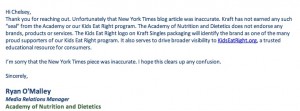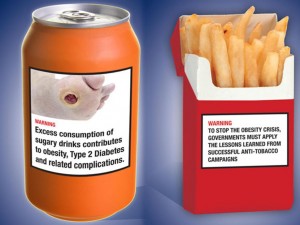Conflicts of interest in nutrition research: recent examples
I’ve been collecting examples of conflicted research for the past week or so. These are studies paid for in part by food businesses or trade associations with a vested financial interest in the outcome of the research.
These almost invariably promote the financial interests of the sponsor. To wit:
Cocoa flavanol consumption improves cognitive function, blood pressure control, and metabolic profile in elderly subjects: the Cocoa, Cognition, and Aging (CoCoA) Study—a randomized controlled trial, by Daniela Mastroiacovo, Catherine Kwik-Uribe, Davide Grassi, Stefano Necozione, Angelo Raffaele, Luana Pistacchio, Roberta Righetti, Raffaella Bocale, Maria Carmela Lechiara, Carmine Marini, Claudio Ferri, and Giovambattista Desideri. Am J Clin Nutr 2015; 101:538-548 doi:10.3945/ajcn.114.092189.
- Conclusion: These data suggest that the habitual intake of flavanols can support healthy cognitive function with age.
- Sponsor: Mars, Inc.
Sugar-Sweetened Product Consumption Alters Glucose Homeostasis Compared with Dairy Product Consumption in Men and Women at Risk of Type 2 Diabetes Mellitus, by Kevin C Maki, Kristin M Nieman, Arianne L Schild, Valerie N Kaden, Andrea L Lawless, Kathleen M Kelley, and Tia M Rains. J Nutr. 2015; 145:459-466 doi:10.3945/jn.114.204503.
- Conclusion: These results suggest that SSP consumption is associated with less favorable values for HOMA2–%S, LMTT disposition index, HDL cholesterol, and serum 25(OH)D in men and women at risk of T2DM vs. baseline values and values during dairy product consumption.
- Sponsor: Dairy Research Institute/National Dairy Council
Squeezing Fact from Fiction about 100% Fruit Juice, by Roger Clemens, Adam Drewnowski, Mario G Ferruzzi, Cheryl D Toner, and Diane Welland. Adv Nutr 2015;6: 236S-243S. doi: 10.3945/an.114.007328.
- Conclusion: The preponderance of evidence supports the position that 100% fruit juice delivers essential nutrients and phytonutrients, provides year-round access to a variety of fruits, and is a cost-effective way to help people meet fruit recommendations.
- Sponsor: Juice Products Association
Can probiotic yogurt prevent diarrhoea in children on antibiotics? A double-blind, randomised, placebo-controlled study, by Michael J Fox, Kiran D K Ahuja, Iain K Robertson, Madeleine J Ball, Rajaraman D Eri. BMJ Open 2015;5:e006474. doi:10.1136/bmjopen-2014-006474.
- Conclusion: A yogurt combination of LGG, La-5 and Bb-12 is an effective method for reducing the incidence of antibiotic-associated diarrhoea in children.
- Sponsor: Parmelat Australia
Chronic consumption of flavanone-rich orange juice is associated with cognitive benefits: an 8-wk, randomized, double-blind, placebo-controlled trial in healthy older adults, by Rebecca J Kean, Daniel J Lamport, Georgina F Dodd, Jayne E Freeman, Claire M Williams, Judi A Ellis, Laurie T Butler, and Jeremy PE Spencer. Am J Clin Nutr 2015; 101:506-514 doi:10.3945/ajcn.114.088518.
- Conclusion: Chronic daily consumption of flavanone-rich 100% orange juice over 8 wk is beneficial for cognitive function in healthy older adults.
- Sponsor: Partially funded by the State of Florida Government, Florida Department of Citrus. The authors report: “Florida Citrus helped designed [sic] the research. None of the authors reported a conflict of interest related to the study.”
Dairy consumption and risk of cardiovascular disease: an updated meta-analysis of prospective cohort studies, by Li-Qiang Qin PhD, Jia-Ying Xu PhD, Shu-Fen Han PhD, Zeng-Li Zhang PhD, You-You Zhao PhD, Ignatius MY Szeto PhD. Asia Pac J Clin Nutr. 2015 Mar;24(1):90-100. doi: 10.6133/apjcn.2015.24.1.09.
- Conclusion: This meta-analysis provided further evidence supporting the beneficial effect of dairy consumption on CVD. Low-fat dairy products and cheese may protect against stroke or CHD incidence.
- Sponsor: Nestec Ltd. (Nestlé R&D (China) Ltd. Two of the authors work for the company (to which I am not related).
In each of these cases, the sponsors got what they paid for. Recent sponsored studies have not come to conclusions contrary to the interests of the sponsor.
Coincidence?
You decide.


 As the Times understates the matter,
As the Times understates the matter,



